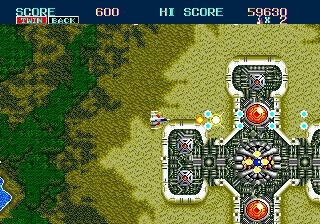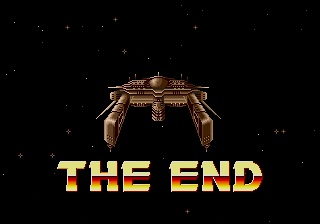
Review Overview
AVERAGE
AVERAGE
A solid launch title with a few launch title issues, Thunder Force II ushers in both the Thunder Force series and the 16-bit era in a bold but perhaps overambitious way.
I know what you’re thinking. “If this is Thunder Force II, a sequel, then where the heck can I find the first game?”
My answer is to that is two fold. First, don’t think so damn much, you’ll break your brain. I’m pretty sure medical science will back me up on that. Second: unless you happened to live in Japan in 1983 and played games on Japanese computers, then you likely missed your opportunity to play the original Thunder Force.
Is it really that big a deal if you’re a bit lost? It’s a shooter, so the plot never really goes beyond “Bullets am coming at ship dodge you can blow up bad things now until game end boom boom lasers!” I mean, come on, it’s not like this is a damn Hideo Kojima bloated waste of memory and effort game. In fact, Thunder Force II is a game by the shooter wizards at Technosoft, and is actually a Genesis/Mega Drive port of a Japanese Sharp X68000 game released in 1988. So that’s cool. Now, let’s talk about something else…
 Oh, fine! The story is that your lone fighter, the Excelzia, represents the Interplanetary Federation’s entire line of defense against the evil Lone Empire led by Reficul, which has created a new super-powerful doomsday battleship called Plealos (or Preareos) that’s so secret, you know exactly where it is hidden and subsequently descend underground over nine stages and blast it into Cheetos dust. Again, we’re not talking Shakespearean levels of plot intricacy here. Boom boom lasers!
Oh, fine! The story is that your lone fighter, the Excelzia, represents the Interplanetary Federation’s entire line of defense against the evil Lone Empire led by Reficul, which has created a new super-powerful doomsday battleship called Plealos (or Preareos) that’s so secret, you know exactly where it is hidden and subsequently descend underground over nine stages and blast it into Cheetos dust. Again, we’re not talking Shakespearean levels of plot intricacy here. Boom boom lasers!
The nine stages in the game are split between two different perspectives, overhead free-roaming stages and more traditional side-scrolling ones, with odd numbered stages being the former and the even numbered ones the latter. With each stage, you delve deeper underground toward your final destination of the secret battleship. Hmm… that reminds me of another Genesis game… A free-roaming shooter that takes place in a subterranean environment… in a subterranean environment… Eh, it escapes me for the moment.
 You collect several power-ups along the way, many of which are pretty awesome. You start with the ability to swap between a forward canon and a shot that fires both forward and backward, but you also collect spread shots, satellites called “claws,” and of course, lasers. Boom. You can swap between these weapons on the fly with the press of a button, meeting each challenge with the most appropriate means for inducing death.
You collect several power-ups along the way, many of which are pretty awesome. You start with the ability to swap between a forward canon and a shot that fires both forward and backward, but you also collect spread shots, satellites called “claws,” and of course, lasers. Boom. You can swap between these weapons on the fly with the press of a button, meeting each challenge with the most appropriate means for inducing death.
These weapon upgrades come in quite handy in that Thunder Force II is as tough as deep-fried bison balls, a tradition the Thunder Force series proudly maintained until at least part IV (the last one I played, derp!). You also lose every single weapon upgrade when you die, not just the one you were using at the time, so there is no advantage to saving your best weapon (A-hem! The “hunter” weapon! Cough!). Just fire away.
Boom…
You’re given three lives and six continues to start the game. You’re also able to give yourself an extra life in a secret options menu (hold A+Start at the title screen). Why these options are hidden away with a code is beyond me, but I suggest you use it. At least the game doesn’t throw you back to the beginning of the stage when you die like some other shooters of the era (i.e. R-Type).
The options menu also gives you the ability to start on any of the first five stages, which is a welcome addition. Be warned though, if you start on stage 4, for example, you will progress thus: Stage 4, 5, 1, 2, 3, and both 4 and 5 again, then 6, 7, 8 & 9. So the code isn’t really going to help you beat the game in this case, it actually makes it harder, but if you really, really suck, you can at least skip around and experience a decent portion of the game. Jumping ahead may also help you to learn the locations of the bases or the patterns of the enemies, which is key to advancing successfully.

Oh, the bases? Let’s discuss those. Scattered across the overhead levels, there are 4 main bases that you have to track down, bomb, and destroy before you automatically move on to the next side-scrolling stage. The only real problem with this is that there are no in-game instructions telling you that destroying them is the way to advance, so you may fly around aimlessly for a while before you figure it out (except that I just told you; hooray for me). Even the game’s manual has only this advice for progressing through the stages: “Shoot to survive.” Thanks, a-holes. Boom, boom, lasers.
These free-roaming stages are what sets Thunder Force II apart from other shooters at the time (and subsequent entries in the Thunder Force series). This is both good and bad, depending on your taste. The levels look good enough, especially for an early Genesis title, and they are a good diversion from standard 2D shooter gameplay. However, your ship is constantly moving at a pretty brisk pace, and is always centered smack dab in the middle of the screen. This means that you don’t have very much “looking space” ahead of you when you approach a wall or an enemy, so there are plenty of “Oh, sh-t!” moments where your ship is just barely saved from pounding into an obstacle.
Something that might have fixed this would have been the ability to change your ship’s speed by pressing either A or C (seeing as how both buttons double in their function of swapping weapons), or even shifting the ship off-center based on which direction you are traveling to give you more time to react. As it is, I found that if I traveled mostly in diagonal patterns, I was able to artificially increase my looking space to the corners of the screen (thank you, Pythagorean Theorem!) and that gave me the extra fraction of a second necessary to evade collisions. So, stick to your diagonals. That’s free game strategy gold, folks.
Otherwise, the overhead levels are fine, and they do make up 5/9 of the game (that’s roughly 55.555555555…%). Once you memorize the best paths to reach all of the bases, you can beat these stages pretty quickly, in about two minutes each. I will point out that Stage 5 is particularly difficult to navigate with some tight corridors, so prepare to burn a continue on that one.
…Boom…
Now, side-scrolling stage stuff. Most of these are pretty standard fare, but they are well done. You are given plenty of power-ups throughout, and there are plenty of enemies and obstacles to contend with. There are a few obstacles that you simply have to memorize through multiple attempts, as they are guaranteed to kill you on your first time through; gates that close and don’t reopen, dead-end corridors, that kind of thing. These deaths feel pretty cheap when they occur, so invest in a Genesis-controller-shaped stress ball to save yourself the ten bucks necessary to replace the real ones you might smash.

At least you are given a bit of a reprieve when you reach the bosses at end of these side-scrolling stages, some of whom are easier than an intoxicated sailor on Cialis. So, while they’re sitting in a corner doing the drunken boner stroke in a half-hearted attempt to make you their bitch for the night, kindly introduce them to your friend, Bullets, and be on your merry way. In a game as difficult as Thunder Force II, it was very odd that the boss battles would be considered your “break.” If that is frustrating to you, then you always have Thunder Force IV/Lightening Force (yes, I know that they spelled “Lightning” wrong). Hardly an issue there.
For the first shooter on the console, Thunder Force II performs very well. The game never slowed down and I only noticed flicker during one specific boss fight. I particularly appreciated the color palette used throughout the game. It may have been a bit limited, but there were some very saturated reds and greens used which made the game look slightly less realistic, but more vibrant, and I wish more Genesis games had taken the same graphical approach of deftly employing few, bold colors (the core Sonic series does this very well).
The soundtrack in Thunder Force II definitely set the standard for subsequent titles in the Thunder Force series. It does an overall fine job making use of the Genesis’ FM synth sound chip, and while none of the compositions are likely to stick with you, several of them are very solid. The few voices in the game don’t fare quite so well, as they are just about as scratchy as voices get on the Genesis, so Technosoft definitely gets an “A” for effort, there (and a C+ for actual results)!
…Lasers
 Your enjoyment of Thunder Force II will likely hinge on how you respond to the free-roaming stages. These are slightly more than half of the game, and they are indeed flawed, but they keep the action interesting if you’re not beholden to the typical side-scrolling formula.
Your enjoyment of Thunder Force II will likely hinge on how you respond to the free-roaming stages. These are slightly more than half of the game, and they are indeed flawed, but they keep the action interesting if you’re not beholden to the typical side-scrolling formula.
The Thunder Force series reaches amazing heights by the end of the Genesis’ life span, and it’s cool to see the roots of those later titles. But for Thunder Force II itself, it’s definitely a rougher game with a lot of promise, some interesting ideas, but some unfortunate hiccups in its execution. It still killed any side-scrolling shooters on NES at the time, so at least in that sense, it was very successful as a launch game. But then Thunder Force III came out… and Bio Hazard Battle… and Steel Empire… and Wings of Wor… and Sol Deace…
PROS:
+ Variety of play
+ Surprisingly decent tunes
+ Stage select option for beginners
+ Sets the stage for amazing sequels
CONS:
– Wonky mechanics in overhead stages
– Progression and mission objectives unclear
– Some cheap deaths
– Easy bosses



